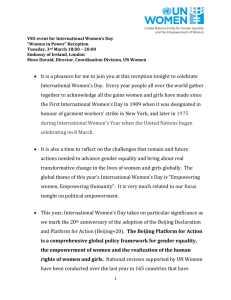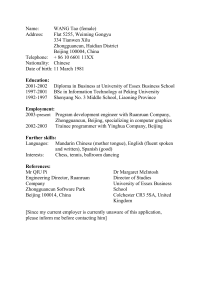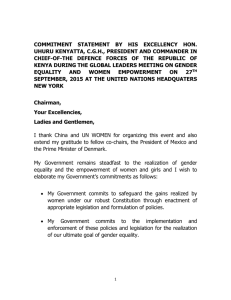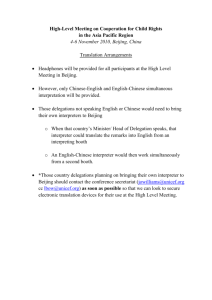Beijing + 15 Strategic Objective Two:
advertisement
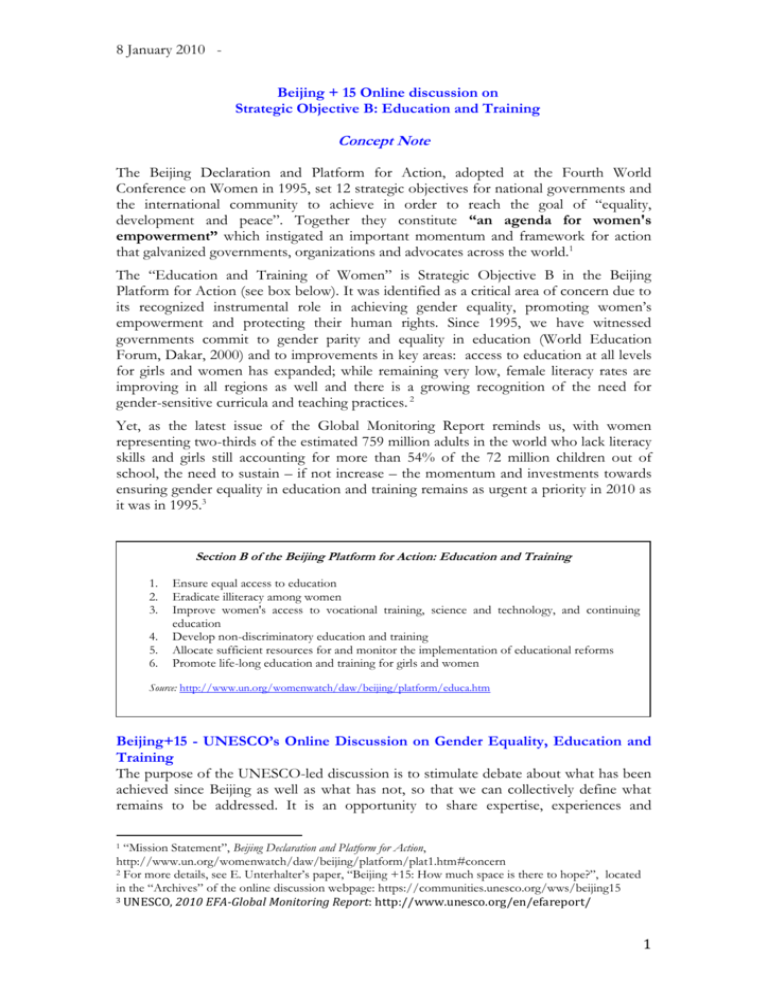
8 January 2010 Beijing + 15 Online discussion on Strategic Objective B: Education and Training Concept Note The Beijing Declaration and Platform for Action, adopted at the Fourth World Conference on Women in 1995, set 12 strategic objectives for national governments and the international community to achieve in order to reach the goal of “equality, development and peace”. Together they constitute “an agenda for women's empowerment” which instigated an important momentum and framework for action that galvanized governments, organizations and advocates across the world.1 The “Education and Training of Women” is Strategic Objective B in the Beijing Platform for Action (see box below). It was identified as a critical area of concern due to its recognized instrumental role in achieving gender equality, promoting women’s empowerment and protecting their human rights. Since 1995, we have witnessed governments commit to gender parity and equality in education (World Education Forum, Dakar, 2000) and to improvements in key areas: access to education at all levels for girls and women has expanded; while remaining very low, female literacy rates are improving in all regions as well and there is a growing recognition of the need for gender-sensitive curricula and teaching practices. 2 Yet, as the latest issue of the Global Monitoring Report reminds us, with women representing two-thirds of the estimated 759 million adults in the world who lack literacy skills and girls still accounting for more than 54% of the 72 million children out of school, the need to sustain – if not increase – the momentum and investments towards ensuring gender equality in education and training remains as urgent a priority in 2010 as it was in 1995.3 Section B of the Beijing Platform for Action: Education and Training 1. 2. 3. 4. 5. 6. Ensure equal access to education Eradicate illiteracy among women Improve women's access to vocational training, science and technology, and continuing education Develop non-discriminatory education and training Allocate sufficient resources for and monitor the implementation of educational reforms Promote life-long education and training for girls and women Source: http://www.un.org/womenwatch/daw/beijing/platform/educa.htm Beijing+15 - UNESCO’s Online Discussion on Gender Equality, Education and Training The purpose of the UNESCO-led discussion is to stimulate debate about what has been achieved since Beijing as well as what has not, so that we can collectively define what remains to be addressed. It is an opportunity to share expertise, experiences and “Mission Statement”, Beijing Declaration and Platform for Action, http://www.un.org/womenwatch/daw/beijing/platform/plat1.htm#concern 2 For more details, see E. Unterhalter’s paper, “Beijing +15: How much space is there to hope?”, located in the “Archives” of the online discussion webpage: https://communities.unesco.org/wws/beijing15 3 UNESCO, 2010 EFA-Global Monitoring Report: http://www.unesco.org/en/efareport/ 1 1 8 January 2010 knowledge from all regions of the world in order to renew and revive the commitments made in 1995 and then in 2000 by the UN General Assembly and the Dakar World Education Forum. The international policy landscape has changed significantly - and favourably – since Beijing. A key change has been the linking of efforts to promote girls’ and women’s empowerment to the struggle for gender equality. This is more than a change in terminology. It has led the international community to commit to equality between women and men as well as to transform gender dynamics so that women and men can lead equally healthy, fulfilling and rewarding lives. Gender equality in the context of education refers to the right of girls and boys, women and men, to non-sexist, empowering, quality education throughout life. It also encompasses issues pertaining to the content of education, pedagogy and learning environments that have far-reaching implications. In this sense gender equality in education is not only a human right, it also has multiple socio-economic benefits. Indeed, the “domino effect” of socio-economic benefits (improved HIV/AIDS awareness, maternal and child mortality rates, economic development) has helped motivate governments and multilateral organizations to invest in the education and training of girls and women. Other internationally agreed development targets, notably the Millennium Development Goals (MDGs) and the six Education for All Goals, have taken up Beijing’s objectives for education and training, testifying to their ongoing relevance. For the online discussion, UNESCO has chosen three themes within which the achievements, gaps and challenges related to Strategic Objective B will be examined. Week One (10-16 Jan) – “Disconnects: missed opportunities for progress and lessons learned” This first week will take a critical look at the past 15 years to assess the various missed opportunities for positive collaboration in favour of the Beijing agenda. It is our understanding that the ambitious vision of Beijing has become reduced to narrower definitions and agendas as a result of numerous disconnects. One of the most obvious of these is the disconnect between education and gender advocates. This has led to sectoral approaches failing to effectively mainstream gender equality considerations into their programmes. Another lingering challenge has been the rifts that separate civil society movements, different levels of government and international coalitions for education, such as the EFA movement. Where have the challenges been most apparent and what have we learned from them? How can we better harness the full potential of the Education for All movement to promote women’s empowerment and gender equality in education and training? How can the connections between the global and the national be improved for a more effective response to local concerns and needs? Week Two (17-23 Jan.) – “Silences and hidden challenges” This week will explore the issues not raised within the Beijing Platform for Action either because they have since emerged as areas of concern, or they deal with the “silent marginalized” of society, or because of associated taboos that have so far prevented the silences from being addressed by the international community. 2 8 January 2010 - Harassment and gender based violence in and around schools is one such silence that is compounded by socio-cultural taboos, unreliable statistics and underreporting. Silences also surround the educational needs and experiences of particular groups of women and girls - such as disabled women and girls, women living with HIV/AIDS and women from minority and migrant populations – that are rarely featured in public discourses on education. Another issue that is inadequately discussed is the low priority given to lifelong educational opportunities for girls and women by governments and agencies. The deprioritization of tertiary and vocational education and training over the years is a concern due to the increasing numbers of girls successfully completing basic as well as secondary education. Which issues do you consider to be deprioritized in current policy debates? How do we break the silences around gender discrimination and gender-based violence in education as well as challenge and debate issues where there are deeply held beliefs, values and practices? How do we engage girls, boys, teachers, parents and other stakeholders in combating violence against girls? What are the shortcomings of education-sector responses to the various forms of inequalities that exacerbate gender inequalities? Week Three (24-30 Jan.) - “Crises: challenges and new opportunities” This week will look at the impact of the intersecting global crises (energy, food, economic and financial) on gender equality in education and training. Within a context of competing global priorities gender equality in education and training is likely to be overshadowed. This is problematic, as recent research indicates that gender equality initiatives in education and training must continue to be prioritized because they increase the social protection of women who are among the most vulnerable to these crises. Moreover, they produce benefits that flow to their families and their communities, and as such are viable and effective strategies for sustainable development. Educated and trained women are not only able to better provide for the needs of their families, but are also able to contribute to their communities through, for example, the better management of resources, the generation of stable income through the creation of small businesses and an improved awareness of health issues and disease prevention practices. What can we do to ensure that women’s right to education is secured during times of crises and promptly translates into improvements in their quality of life? What kind of education is needed to tackle the multiple crises and promote women’s and girls’ active engagement in sustainable development processes? Week Four (31 Jan.-7 Feb) – “Summary of discussions: Key messages” This week will look at the key messages that emerged and developed during the course of the discussion. It will provide a broad overview of main discussion points, in particular any new areas of concern or challenges that have arisen since Beijing. 3

